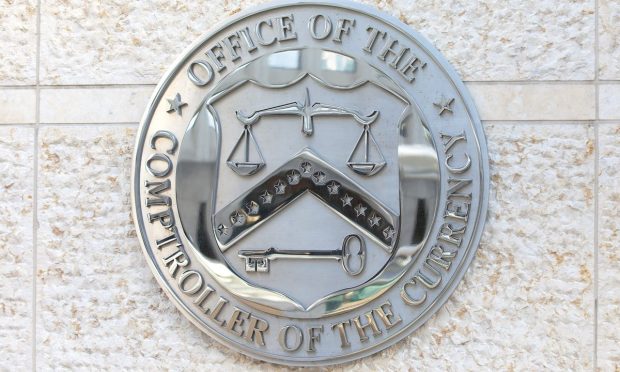US Comptroller Takes a Victory Lap on Crypto

It wasn’t exactly an “I told you so,” but Comptroller of the Currency Michael Hsu didn’t mince words either when discussing crypto’s place in the Semiannual Risk Prospective report released Thursday (June 23).
With a stablecoin’s $48 billion collapse last month, Hsu said: “There are some vulnerabilities and risks in that space that do warrant a cautious and careful approach,” which is a fairly sizable understatement.
“It kind of reinforced where we’ve been this whole time,” Hsu added, referring to a warning letter he issued shortly after taking over the Office of the Comptroller of the Currency (OCC) that essentially reversed his predecessor’s attempts to push the banking industry to get more involved with crypto.
Former OCC head Brian Brooks, who came to the agency from his position as general counsel of crypto exchange Coinbase, had issued a trio of interpretive letters that allowed banks to custody cryptocurrencies for customers, hold stablecoin reserve funds backing their dollar peg, and most importantly allowed banks to use stablecoins for payments.
At the time, Jeremy Allaire, CEO of USDC stablecoin issuer Circle, said the latter ruling “paves the way for the use of leading dollar digital currencies such as USDC as a mainstream payment medium for all forms of payments and settlement.”
See also: Comptroller of the Currency Backpedals on Rulings Allowing Banks to Handle Crypto
That was right up until Hsu took over.
Citing the “novel risks” of crypto assets, a Nov. 23 interpretive letter warned that “banks must be able to demonstrate that they have appropriate risk management systems and controls in place to conduct them safely.”
Beyond that, they had to get the OCC’s approval of those systems and controls ahead of time. The risk report essentially repeated all that.
What the OCC left unsaid: Good luck with that.
Power Play
Hsu hasn’t had any problems with the conclusions of the President’s Working Group (PWG) on Financial Markets report on stablecoins, which recommended that they only be issued by federally licensed, FDIC insured banks.
Hsu said in January that a then-hypothetical “stablecoin run would not just impact those directly invested in it. There would be collateral damage.”
The best way to mitigate those risks is bank regulation, which “would give credibility to the ‘stable’ part of stablecoins,” Hsu said. It would give investors confidence that even during a crisis, “the reserves would be there, overseen and examined by bank supervisors, and potentially even backstopped” by the Federal Reserve.
The collapse of the terraUSD stablecoin and its partner token, LUNA — which the algorithmic stablecoin used in an arbitrage-based method of maintaining its peg — probably strengthened Hsu’s hand, at least in terms of ensuring the PWG recommendations make it into the final proposal for a comprehensive regulatory framework for cryptocurrencies that government agencies are due to present the president in September.
The collapse also probably weakened the hand of members of Congress in both parties who would like to see state regulators able to oversee stablecoin issuers as well.
By the same token, it could also prove to be a double-edged sword for Hsu.
TerraUSD not only showed the danger and speed of a stablecoin run. It also highlighted just how big a commitment the government would be taking on if stablecoins came with $250,000 FDIC insurance.
“I certainly think this has given pause to a lot of people to linking this to the FDIC insurance fund,” said Nathan Dean, a Bloomberg Intelligence analyst.
After all, a stablecoin failure here, a run there, and pretty soon you’re talking about real money.
Other OCC officials on the call said that watching the meltdown of the algorithmic stablecoin and other industry troubles has taught regulators a lot about crypto — especially the confusing use of language in this space. When it comes to the custody of customer funds, the OCC has noted exchanges trying to explain themselves on what custody means for them, which is very different from what it means for banking. They added that industry disclosures continue to be a concern, because customers may not understand what they’re getting into.
Hsu hasn’t come out against stablecoins, he said in early April, noting that they were too big to ignore. Along with ensuring stability, one of his top concerns was ensuring they are interoperable with each other.
Read more: OCC’s Comptroller Wants Stablecoins to Be Interoperable With US CBDC
Noting that runs are destructive like hurricanes in that they do not discriminate “between those who deserve to bear losses and those who are innocent,” he pointed out that this was particularly true of shadow banks in 2008.
Fortunately, he said, there is an effective tool to mitigate those risks: Bank regulation, which Hsu said would boost investors’ confidence.
That’s when Hsu worked his back innovations, arguing that “regulating stablecoin issuers as banks could also enable more innovation in crypto and make those innovations more durable.”
He added, “While innovation thrives in uncertain environments, solid foundations can help, especially when it comes to money and trust.”
Sign up here for daily updates on all of PYMNTS’ Crypto coverage.
